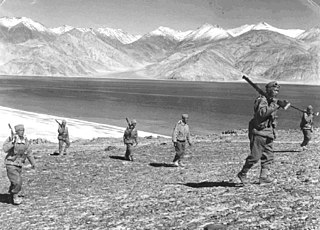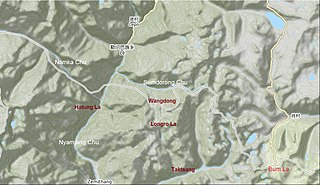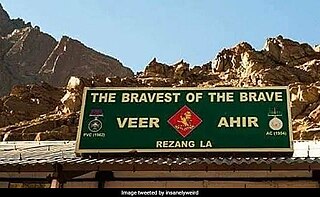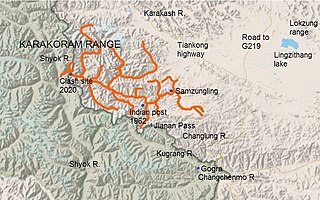
The Sino–Indian War, also known as the China–India War or the Indo–China War, was an armed conflict between China and India that took place from October to November 1962. It was a military escalation of the Sino–Indian border dispute. Fighting occurred along India's border with China, in India's North-East Frontier Agency east of Bhutan, and in Aksai Chin west of Nepal.

The Line of Actual Control (LAC), in the context of the Sino-Indian border dispute, is a notional demarcation line that separates Indian-controlled territory from Chinese-controlled territory. The concept was introduced by Chinese premier Zhou Enlai in a 1959 letter to Jawaharlal Nehru as the "line up to which each side exercises actual control", but rejected by Nehru as being incoherent. Subsequently, the term came to refer to the line formed after the 1962 Sino-Indian War.

The Kumaon Regiment is one of the oldest infantry regiments of the Indian Army. The regiment traces its origins to the 18th century and has fought in every major campaign of the British Indian Army and the Indian Army, including the two world wars, and is one of the highest decorated regiments of the Indian Army.

The Special Frontier Force (SFF) is a paramilitary Indian special forces unit composed primarily of Tibetan refugees and Gurkhas in India. It was established after the Sino-Indian War of 1962 to primarily conduct covert operations behind the Chinese lines in case of another war with China. Later it increased in size and scope of operations.

Operation Meghdoot was the codename for the Indian Armed Forces operation to take full control of the Siachen Glacier in Ladakh. Executed on the morning of 13 April 1984 in the highest battlefield in the world. This operation preempted Pakistan's Operation Ababeel and was a success, resulting in Indian forces gaining control of the Siachen Glacier in its entirety.
Rezang La is a mountain pass on the Line of Actual Control between Indian-administered Ladakh and the Chinese-administered Spanggur Lake basin. The pass is located on the watershed ridge of the Chushul Valley, on its east. China claims that the ridge is the boundary between the two countries, while India's claim line is further east.

Major Shaitan Singh Bhati, PVC was an Indian Army officer and recipient of India's highest military decoration, the Param Vir Chakra. Singh was born in Rajasthan. On completing his graduation, Singh joined the Jodhpur State Forces. He was transferred to the Kumaon Regiment after the princely state of Jodhpur was merged into India. He took part in operations in the Naga Hills and also in the 1961 Indian annexation of Goa.

In 1986–87, a military standoff took place between India and China in the Sumdorong Chu Valley bordering the Tawang district, Arunachal Pradesh and Cona County, Tibet. It was initiated by China moving a company of troops to Wangdung, a pasture to the south of Sumdorong Chu that India believed to be its territory. The Indian troops stood their ground on the neighbouring Longro La ridge and both the sides moved a large number of troops to the border. The crisis was diffused after the visit of Indian External Affairs minister to Beijing in May 1987. The standoff gave rise to fears of escalation. Subsequently, India and China formulated agreements for managing future border tensions.

Thoise or Thoise Air Force Station is a military airfield and small village in Nubra region of Ladakh, India, occupying the only large piece of flat land in the area. The airstrip is a critical facility enabling a quick inflow of men and material from the Indian interior to Siachen, a glacier, helipad and battleground near the Actual Ground Position Line between India and Pakistan.
The Depsang Plains, a high-altitude gravelly plain in the northwest portion of the disputed Aksai Chin region of Kashmir, divided into Indian and Chinese administered portions by a Line of Actual Control. India controls the western portion of the plains as part of Ladakh, while the eastern portion is controlled by China and claimed by India. The Line of Control with Pakistan-administered Gilgit-Baltistan is 80 kilometres (50 mi) west of the Depsang Plains, with the Siachen Glacier in-between. Ladakh's traditional trade route to Central Asia passed through the Depsang Plains, with the Karakoram Pass lying directly to its north.
Chushul is a village in the Leh district of Ladakh, India. It is located in the Durbuk tehsil, in the area known as "Chushul Valley", south of the Pangong Lake and west of the Spanggur Lake. The Line of Actual Control with China runs about 5 miles east of Chushul, across the Chushul Valley. Famous as site for historical battle grounds.

The 2013 Depsang standoff, also called 2013 Depsang incursion, or 2013 Daulat Beg Oldi incident, was an incursion and sit-in by a platoon-sized contingent of the Chinese PLA in the dry river bed of Raki Nala, in the Depsang Bulge area, 30 km south of Daulat Beg Oldi near the Line of Actual Control (LAC) in the disputed Aksai Chin region.
The Galwan River flows from the disputed Aksai Chin area administered by China to the Union Territory of Ladakh, India. It originates near the caravan campsite Samzungling on the eastern side of the Karakoram range and flows west to join the Shyok River. The point of confluence is 102 km south of Daulat Beg Oldi. Shyok River itself is a tributary of the Indus River, making Galwan a part of the Indus River system.

Gurung Hill is a mountain near the Line of Actual Control between the Indian- and Chinese-administered portions of Ladakh near the village of Chushul and the Spanggur Lake. As of 2020, the Line of Actual Control runs on the north–south ridgeline of Gurung Hill. To the west of Gurung lies the Chushul valley and to the right of it are mountains of Kailash Range forming the basins of the Spanggur Lake and the Pangong Lake in this area.
20th Lancers is an armoured regiment in the Armoured Corps of the Indian Army. The regiment distinguished itself in operations with its defence of Chhamb in Jammu and Kashmir during the 1965 Indo-Pakistan War and won one Maha Vir Chakra. It has provided one Chief of Army Staff and two Army Commanders.

The Battle of Rezang La was a major military engagement that took place on 18 November 1962, during the Sino-Indian War between the Indian Army's 13th Kumaon Regiment and China's People's Liberation Army (PLA). 120 Indian soldiers of all-Ahir Charlie C Company faced more than 3000 Chinese soldiers and successfully defended the strategic mountain pass of Rezang Lah in Ladakh. Fought at an altitude of 16,000 feet, against overwhelming Chinese forces, the battle saw one of the greatest last stands, with Indian sources documenting more than 1400 Chinese casualties. Major Shaitan Singh, who led the defense, was posthumously awarded the Param Vir Chakra, India's highest military honor, for his extraordinary bravery. Several other decorations were awarded posthumously to many officers and soldiers of the company.
The Depsang Bulge or Burtsa Bulge is a 900-square-kilometre area of mountain terrain in the disputed Aksai Chin region, which was conceded to India by China in 1960, but has remained under Chinese occupation since the 1962 Sino-Indian War. The area is immediately to the south of the Depsang Plains and encloses the basin of the Burtsa Nala, a stream originating in the Aksai Chin region and flowing west to merge with the Depsang Nala near the village of Burtsa in Ladakh, eventually draining into the Shyok River. The area is perceived to be of strategic importance to both the countries, sandwiched by strategic roads linking border outposts. Since 2013, China has made attempts to push the Line of Actual Control further west into Indian territory, threatening India's strategic road.

The Battle of Walong took place during the Sino-Indian War of 1962. It took place near the town of Walong in the eastern sector of the conflict, in the present-day Arunachal Pradesh region of India. Indian forces, despite being outnumbered and under equipped, resisted the Chinese advance for nearly a month.
13 Field Regiment (Chushul and Gadra City) is part of the Regiment of Artillery of the Indian Army, and has the distinction of having two post-independence honour titles.

The Battle of Galwan was one of the key engagements in the western sector of Ladakh during the Sino-Indian War of 1962. The Galwan Valley, located near the Line of Actual Control (LAC) in Ladakh, held strategic significance for both India and China. Tensions escalated in the months leading up to the war, with China seeking to expand its control over disputed territories.













